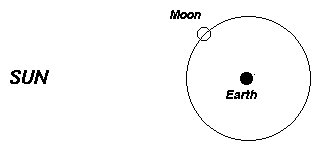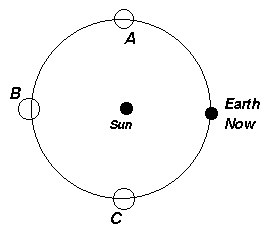ASTR 1210 (O'Connell)
ANSWERS TO SAMPLE EXAM QUESTIONS
In which direction does the Sun appear to move from one day to the next with respect to the stars? A) north; B) south; C) east; D) west. C) east A healthy, fruit-based model of the nearby stars in which the Sun was the size of an orange would have to be how large in size just to contain the next nearest star? A) 100 feet; B) 100 yards; C) 1 mile; D) 10 miles E) thousands of miles. E) thousands of miles. (T/F) A particular constellation rises at the same time every night. False [because the sun moves eastward through the constellations at a rate of about 1 degree a day, a given group of stars rises 4 minutes earlier each night.] An alien visitor from a planet with a slow rotation period becomes nostalgic for long nights. Where on the Earth's surface would you recommend that she goes? A) to the poles; B) to the equator; C) to Las Vegas; D) sorry: all places on Earth have days with equal lengths. A) to the poles.
 This sketch shows the Sun, Earth, and the Moon at a particular point
in its orbit. In what "phase" will the Moon be at this time as viewed
from Earth? A) Full; B) First quarter; C) Crescent; D) New. C)
Crescent.
The retrograde motion of Mars can best be explained as: A) Mars
reversing its motion in its orbit; B) the Earth reversing its motion
in its orbit; C) the Earth overtaking and passing Mars; D) the stars
reversing their motion. C) Earth overtaking
The "obliquity of the ecliptic" is defined to be the angle between the
Earth's rotation axis and a direction perpendicular to the plane of
the ecliptic. This angle is presently 23.5 degrees. If it were 60
degrees instead, seasonal changes would be A) the same as now, since
seasons depend only on the Earth's distance from the Sun; B)
more extreme; C) less extreme. B) more extreme
Which of the following has the more complicated path in the sky
with respect to the stars, as seen with the naked eye? A) the
Sun; B) the Moon; C) Venus. C) Venus.
Kepler's Second Law implies that when a planet is nearer the Sun, its
speed in its orbit A) increases; B) decreases; C) stays the same.
A) increases
This sketch shows the Sun, Earth, and the Moon at a particular point
in its orbit. In what "phase" will the Moon be at this time as viewed
from Earth? A) Full; B) First quarter; C) Crescent; D) New. C)
Crescent.
The retrograde motion of Mars can best be explained as: A) Mars
reversing its motion in its orbit; B) the Earth reversing its motion
in its orbit; C) the Earth overtaking and passing Mars; D) the stars
reversing their motion. C) Earth overtaking
The "obliquity of the ecliptic" is defined to be the angle between the
Earth's rotation axis and a direction perpendicular to the plane of
the ecliptic. This angle is presently 23.5 degrees. If it were 60
degrees instead, seasonal changes would be A) the same as now, since
seasons depend only on the Earth's distance from the Sun; B)
more extreme; C) less extreme. B) more extreme
Which of the following has the more complicated path in the sky
with respect to the stars, as seen with the naked eye? A) the
Sun; B) the Moon; C) Venus. C) Venus.
Kepler's Second Law implies that when a planet is nearer the Sun, its
speed in its orbit A) increases; B) decreases; C) stays the same.
A) increases
 This sketch represents the orbit
of the Earth seen from a point above its North pole. If the Earth is
presently at the point labeled "now". at which point will it be in 3
months? Point A. [As seen from above its North pole,
the Earth moves counterclockwise in its orbit. It moves 1/4 of
the distance around the sun in 3 months.]
Of which of the following did the Greeks not have an appreciation? A)
size of Earth; B) nature of lunar phases; C) shape of Earth; D)
Jupiter's satellites; E) approximate distance to sun. D)
Jupiter's satellites---requires a telescope to detect these.
[Brief answer question---2-3 sentences.] Why was the {\it accuracy} of
Tycho's observations of the planets important in the resolution of the
controversy over the structure of the solar system? Kepler knew and
respected the accuracy of Tycho's observations. He insisted his model
orbits fit Tycho's data for Mars to the known uncertainty in Tycho's
observations. This led him to discard other models and realize that
Mars' orbit was an ellipse with the Sun at one focus.
[Harder question:] If a full Moon occurs on March 21, you know that
the Moon's location in the sky must be: A) near the celestial equator;
B) about 23 degrees from the celestial equator; C) near the North
Pole; D) in the constellation Cygnus. A) near the celestial
equator. [At full moon, the Moon is 180 degrees away from the Sun.
The Moon's orbit is almost in the plane of the ecliptic (maximum
distance only 5 degrees.) Since the Sun is on the celestial equator
at March 21 (the vernal equinox), then the Moon must be 180 degrees
away and on the ecliptic, which means it is near the celestial
equator at the autumnal equinox. The Moon can never be near the
North Pole or Cygnus since those points are not near the ecliptic
plane.]
[Fill in.] With his telescope, Galileo made a remarkable discovery
about the appearance of the planet Venus. What was it? It shows
phases.
If the Moon were twice as far away from Earth as it is today, the
"month", as defined by the cycle of lunar phases, would be (A) longer;
(B) shorter; (C) the same length as today. A) longer [because,
according to Kepler's third law, it would take the Moon longer to
complete one orbit around the Earth.]
An object launched at twice the escape velocity from the Earth will
be moving with respect to the Earth in A) a circular orbit; B) a bound
orbit; C) an unbound orbit; D) an elliptical orbit. C) an unbound
orbit
(T/F) "Experiment is the sole source of truth" is the kind of
quotation which one finds in the work of Greek philosophers like Plato
and Aristotle. False. [The Greeks favored deduction from abstract
postulates over experiment.]
The astronomical alignments at Stonehenge are associated with the
positions of celestial objects A) at noon; B) at rise or set; C)
at midnight. B) at rise or set.
Jupiter's orbit has a radius of approximately
5 Astronomical Units. If the Earth were moved to Jupiter's orbit, how
strong would be the gravitational force exerted on the Earth by the
Sun ? Express the answer as a ratio to the force exerted at present:
A) 1/100; B) 1/25; C) 1/5; D) the same; E) 5 times larger; F) 25 times
larger. B) 1/25 [according to Newton's inverse-r-squared force
law for gravity]
This sketch represents the orbit
of the Earth seen from a point above its North pole. If the Earth is
presently at the point labeled "now". at which point will it be in 3
months? Point A. [As seen from above its North pole,
the Earth moves counterclockwise in its orbit. It moves 1/4 of
the distance around the sun in 3 months.]
Of which of the following did the Greeks not have an appreciation? A)
size of Earth; B) nature of lunar phases; C) shape of Earth; D)
Jupiter's satellites; E) approximate distance to sun. D)
Jupiter's satellites---requires a telescope to detect these.
[Brief answer question---2-3 sentences.] Why was the {\it accuracy} of
Tycho's observations of the planets important in the resolution of the
controversy over the structure of the solar system? Kepler knew and
respected the accuracy of Tycho's observations. He insisted his model
orbits fit Tycho's data for Mars to the known uncertainty in Tycho's
observations. This led him to discard other models and realize that
Mars' orbit was an ellipse with the Sun at one focus.
[Harder question:] If a full Moon occurs on March 21, you know that
the Moon's location in the sky must be: A) near the celestial equator;
B) about 23 degrees from the celestial equator; C) near the North
Pole; D) in the constellation Cygnus. A) near the celestial
equator. [At full moon, the Moon is 180 degrees away from the Sun.
The Moon's orbit is almost in the plane of the ecliptic (maximum
distance only 5 degrees.) Since the Sun is on the celestial equator
at March 21 (the vernal equinox), then the Moon must be 180 degrees
away and on the ecliptic, which means it is near the celestial
equator at the autumnal equinox. The Moon can never be near the
North Pole or Cygnus since those points are not near the ecliptic
plane.]
[Fill in.] With his telescope, Galileo made a remarkable discovery
about the appearance of the planet Venus. What was it? It shows
phases.
If the Moon were twice as far away from Earth as it is today, the
"month", as defined by the cycle of lunar phases, would be (A) longer;
(B) shorter; (C) the same length as today. A) longer [because,
according to Kepler's third law, it would take the Moon longer to
complete one orbit around the Earth.]
An object launched at twice the escape velocity from the Earth will
be moving with respect to the Earth in A) a circular orbit; B) a bound
orbit; C) an unbound orbit; D) an elliptical orbit. C) an unbound
orbit
(T/F) "Experiment is the sole source of truth" is the kind of
quotation which one finds in the work of Greek philosophers like Plato
and Aristotle. False. [The Greeks favored deduction from abstract
postulates over experiment.]
The astronomical alignments at Stonehenge are associated with the
positions of celestial objects A) at noon; B) at rise or set; C)
at midnight. B) at rise or set.
Jupiter's orbit has a radius of approximately
5 Astronomical Units. If the Earth were moved to Jupiter's orbit, how
strong would be the gravitational force exerted on the Earth by the
Sun ? Express the answer as a ratio to the force exerted at present:
A) 1/100; B) 1/25; C) 1/5; D) the same; E) 5 times larger; F) 25 times
larger. B) 1/25 [according to Newton's inverse-r-squared force
law for gravity]
 Questions
Questions
|
 Review Index
Review Index
|